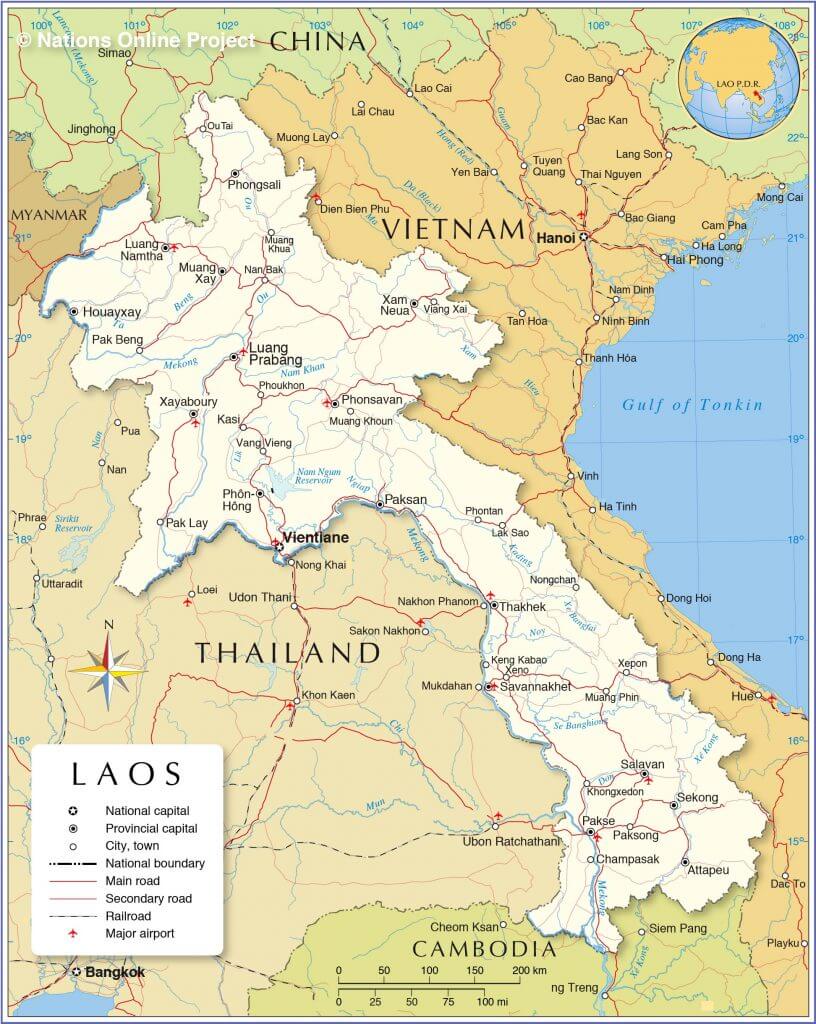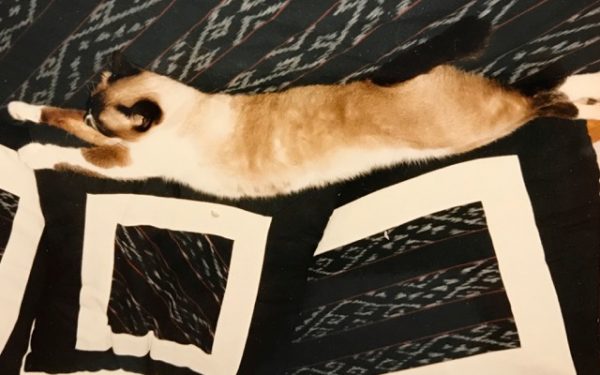#17: Laos 1991-1993, Flora and Fauna
As we did everywhere, we shared our lives with other creatures in a garden that someone else had already started. Laos was a little different in that some of the creatures were not your basic pets, and the garden was already overflowing with abundance.
1991
March 16
Our family has been expanded by one. Exactly one week after I arrived, we were at the Australian Club for a swim, and Russell saw a notice on the board asking for someone to adopt a cat. We’d been thinking about a pet, and it turned out the owners live next door and are moving back to Australia. So “Maeo” has come to live with us. Her name means “cat” in Lao, and we call her “Madame Maeo” (pronounced “mao”), because it appeals to our sense of irony. She’s three-quarters Burmese mixed with one-quarter indescribable, and she’s quite attractive.
March 28
 The gardenias are blooming. We have two gardenia bushes outside our front door, and both are in bloom. I bring in one blossom at a time, and it perfumes the whole house. This is not to mention all the other great plants that are doing their thing in our garden: bougainvillea, plumeria (also called frangipani), many varieties of coleus, morning glories, trumpet vine, and many as yet unidentified tropical plants, including one that looks like banana and has a wonderful, exotic bloom of cascading red-and-yellow. We’re adding to this profusion with plants bought at nearby nurseries and seeds bought in Thailand.
The gardenias are blooming. We have two gardenia bushes outside our front door, and both are in bloom. I bring in one blossom at a time, and it perfumes the whole house. This is not to mention all the other great plants that are doing their thing in our garden: bougainvillea, plumeria (also called frangipani), many varieties of coleus, morning glories, trumpet vine, and many as yet unidentified tropical plants, including one that looks like banana and has a wonderful, exotic bloom of cascading red-and-yellow. We’re adding to this profusion with plants bought at nearby nurseries and seeds bought in Thailand.
June 6
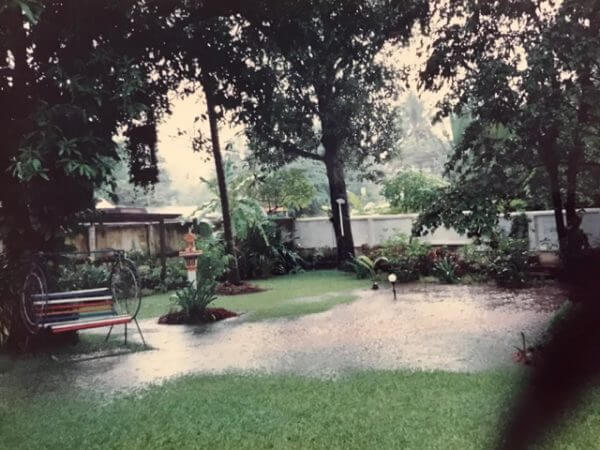 The rainy season seems to have truly begun. The temperature has dropped considerably, and we need air conditioning less and less often to sleep. Of course, the garden is going bonkers. It’s so easy to get things to grow during this season that we’re propagating gardenias just by cutting off a branch and sticking it in the ground.
The rainy season seems to have truly begun. The temperature has dropped considerably, and we need air conditioning less and less often to sleep. Of course, the garden is going bonkers. It’s so easy to get things to grow during this season that we’re propagating gardenias just by cutting off a branch and sticking it in the ground.
June 27
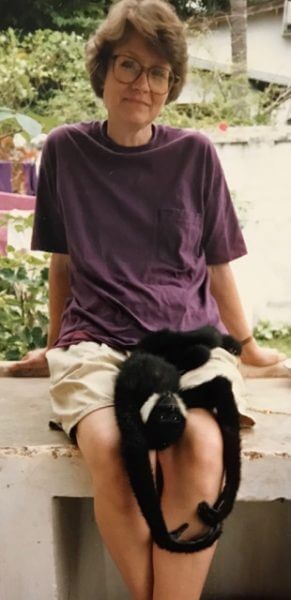 We have a new family member — a baby gibbon, all black with beige side whiskers like Martin Van Buren. Right now, he’s smaller than the cat, although his arms seem to go on forever. He was brought to the house by a man who works in the neighborhood. His friend, from a village in the North, “found” the baby gibbon in the forest. The local man thought we might buy it. We had such mixed feelings — the proper place for wildlife vs. the fate of this tiny man-like creature. If some rich foreigner didn’t buy him within the next few days, he would probably be killed (and perhaps eaten). We could buy him and return him to the jungle except for one thing: foreigners are not allowed to travel outside Vientiane without specific permission from the government, and it’s not likely we could get permission for such a trip. A long story short (it goes on forever), the gibbon has now come to stay with us. We’re trying to think of names. I like “Monsieur Gentilhomme,” but we haven’t taken any decisions yet. We’ve domesticated dogs and cats, but never gibbons. Hope this works out…
We have a new family member — a baby gibbon, all black with beige side whiskers like Martin Van Buren. Right now, he’s smaller than the cat, although his arms seem to go on forever. He was brought to the house by a man who works in the neighborhood. His friend, from a village in the North, “found” the baby gibbon in the forest. The local man thought we might buy it. We had such mixed feelings — the proper place for wildlife vs. the fate of this tiny man-like creature. If some rich foreigner didn’t buy him within the next few days, he would probably be killed (and perhaps eaten). We could buy him and return him to the jungle except for one thing: foreigners are not allowed to travel outside Vientiane without specific permission from the government, and it’s not likely we could get permission for such a trip. A long story short (it goes on forever), the gibbon has now come to stay with us. We’re trying to think of names. I like “Monsieur Gentilhomme,” but we haven’t taken any decisions yet. We’ve domesticated dogs and cats, but never gibbons. Hope this works out…
July 3
Last week, a monk was walking below a coconut tree and was killed by a falling nut. This unfortunate event decided us on harvesting our two trees. So yesterday, a friend of the gardener came and shinnied up the trees with a long rope tied around his waist and a sharp knife tied some 20 feet down the rope. When he got to the top, he threw the rope over the crown of the tree, tied one end to a bunch of coconuts and hacked them off. The gardener then lowered them to the ground.


They got about 50 nuts from each tree. The harvester took a large share of them in payment (he didn’t want money), and the rest were divided among our staff with some for us. At one point, a strong wind came up, and the man was swaying 40 feet in the air. I suggested he come down until the wind stopped, but all the Lao laughed and said not to worry. He seemed perfectly content, although I would have been terrified.
 The gibbon is not doing well. Because I’ve been sick in bed, I haven’t been able to give him the large amount of attention that he needs to settle in during his first days. This means he’s not adjusting well. R has done his best early in the morning, at lunch time and in the evening, but it’s not the same as having someone be there throughout the day. As you know, primates are very social, plus this one is very young, needing a lot of attention. He gets frantic whenever someone tries to leave after being with him for 5-10 minutes. It might be best if we could give him up to live in a better situation. We’ve always wanted to return him to the wild, but he’s so young, that may not be practical.
The gibbon is not doing well. Because I’ve been sick in bed, I haven’t been able to give him the large amount of attention that he needs to settle in during his first days. This means he’s not adjusting well. R has done his best early in the morning, at lunch time and in the evening, but it’s not the same as having someone be there throughout the day. As you know, primates are very social, plus this one is very young, needing a lot of attention. He gets frantic whenever someone tries to leave after being with him for 5-10 minutes. It might be best if we could give him up to live in a better situation. We’ve always wanted to return him to the wild, but he’s so young, that may not be practical.
July 8
Big excitement here: tooth and fang in the tropics. Our resident lizard, Herman, defended his family from a three-foot long green snake right on our front terrace while we watched. Herman and his wife, Hermione, and their young Hermanettes live between the roof and the ceiling of the terrace, coming out at night to feed on insects drawn to the porch light. Herman is about a foot long and very husky. The snake climbed up the bougainvillea toward their nest, and Herman dove out of the heights onto his coils, jaws snapping. The snake let go, and Herman dropped to the floor. The snake went up into the area where the lizards live, but they all escaped through cracks. The snake came back out, and he and Herman had another knock-down-drag-out fight, thrashing and biting and kicking (the one who had feet to kick with). The snake finally left. Our gardener says this snake will not hurt us, so we’re pretty relaxed about his presence. Besides, everyone has snakes in their garden.
July 26
Both sadly and happily, we’ve found the gibbon a new home. Through a mutual friend, we met a Frenchman who works on an irrigation project in the North. He’s very fond of animals and has quite a number of them on 35 acres outside the provincial capital of Oudomsay. He took the gibbon up there Wednesday morning (by helicopter, because that’s the only way you can get there in the rainy season). The gibbon will run free in a protected area where there is an attendant to feed and look after him. We’re very pleased that he’s going to have the kind of home we’d hoped for from the beginning. We’re sorry to see him go, but it’s much better for him.
September 10
While we were at the beach, Mme. Long, our cook-maid, killed a snake in the garden. We can’t tell what kind it was from her description, but it was edible. Our Lao neighbors came over and asked if they could have it for dinner. Since it’s long gone into their tummies, we’ll never know if it was the harmless variety that should 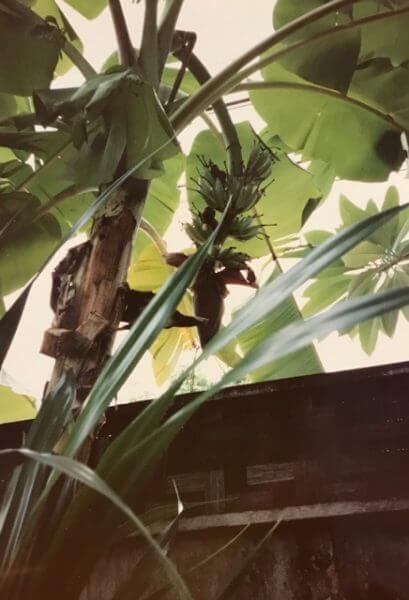 be preserved to eat vermin or one of the species that you’d prefer dead. Mme. Long has been much praised for her bravery in beating the thing to death, so far be it from me to take away her glory.
be preserved to eat vermin or one of the species that you’d prefer dead. Mme. Long has been much praised for her bravery in beating the thing to death, so far be it from me to take away her glory.
September 18
As the rainy season begins to slacken, we’re starting to harvest the fruits of our labor. The papayas are ripening, and we have fresh papaya for breakfast or dessert everyday. We’ve also got bananas on the way, but it’ll be a couple of weeks yet until they’re ready. There’s no comparison between fresh bananas and those we get in Stateside stores.
October 9
 We saw a working elephant just shuffling down the road with his handler and an unidentified load on his back. Laos used to be called “Lan Xiang” (a million elephants), but one sees very few now, so it was a good omen.
We saw a working elephant just shuffling down the road with his handler and an unidentified load on his back. Laos used to be called “Lan Xiang” (a million elephants), but one sees very few now, so it was a good omen.
November 6
Now that the cool season has begun and thanks to seeds carried by [Russell’s brother and wife when they visited], as well as ones we’d brought, we’ve started our vegetable garden: three kinds of lettuce, tomatoes, green peppers, corn, watermelon and herbs. We’re all (Lao and Americans) amazed to see that the lettuce germinated in 4 days! The packet said 7-14. It must be all that good cow dung we put in awhile back.
November 19
Someone stole our bananas! After weeks of watching them develop and begin to ripen, we discovered that someone had reached over the wall in the night and cut the entire stalk. Since we’d never grown our own bananas before, we felt the loss keenly. On the other hand, maybe the person who stole them had a hungry family at home. And we’ve got another stalk just starting, so we’re hoping to eat those in a couple months.
1992
February 12
 A sign that I’ve been here a year is that the exotic red-and-yellow flowers that welcomed me when I arrived have started to bloom again. The family is called Heliconia, and it’s related to cannas even though the plant seems like the banana family. What looks like the flower actually isn’t — tiny little flowers peek out from the flashy bracts.
A sign that I’ve been here a year is that the exotic red-and-yellow flowers that welcomed me when I arrived have started to bloom again. The family is called Heliconia, and it’s related to cannas even though the plant seems like the banana family. What looks like the flower actually isn’t — tiny little flowers peek out from the flashy bracts.
May 19
It’s mango season, and that’s pretty wonderful. We’re growing two kinds in our garden, and there are other types in the market. Breakfast, lunch and dinner: mangoes in a variety of ways — what a nice thing to come home to after our home leave, visiting family and friends, as well as having business meetings in Paris, Brussels, Boston and Honolulu.
I’m happy to report that all the plants I brought from Florida, Virginia and Hawaii made the trip okay and are currently recuperating in pots — 20 of them. If all survive, we’ll have hostas, geraniums, begonias, stephanotis, hyacinths, passion flower, bird of paradise, lilies, most in several colors. This doesn’t include all the seed packets which are waiting for cooler weather so we can have tomatoes, herbs, lettuce and a host of more temperate-climate flowers.
June 11
We finally got to eat our bananas. As you probably remember, we nurtured our first batch until they were almost ready to harvest, and then somebody else got ’em. This time, the tree was trained away from the wall, and we got ’em. I remember the first time I ate fresh bananas — 1964, Hawaii, on the way to India. No comparison with those Kroger bananas. And those Hawaiian bananas don’t compare with picking them off your own tree and slicing them over your cereal five minutes later. (By the way, mango season is over, and the rambutan season has begun.)
Gardener Kham Sing took the remains of the banana flower home to eat, fried. He cut down the tree so that a new one will spring from its roots. In fact, we now have two baby trees from the roots of two others, so we can look forward to fresh bananas again in a few months.
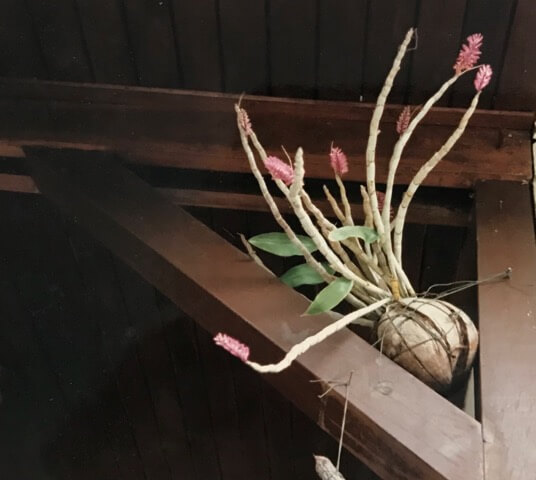
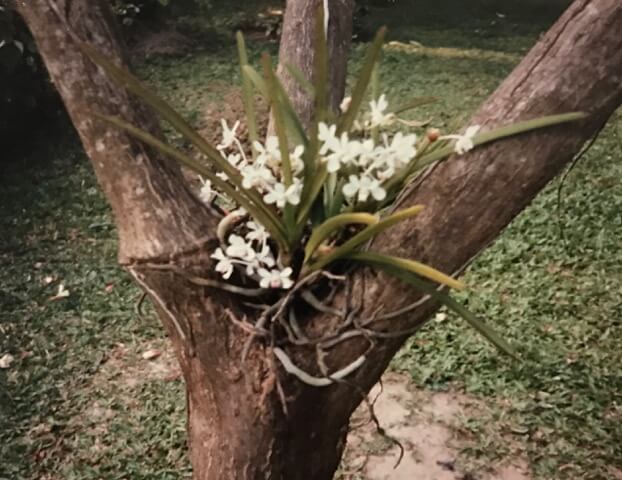
June 17
Our nineteen orchids sit in coconut shells tied in trees and porch brackets. All we do is water them when it doesn’t rain, and God does all the rest. There’s usually at least one in bloom at any time of year. Right now, we have two blooming, with three more in bud. My favorite is the one we call “Lan Xiang.” When blooming, it looks like a long line of tiny white elephant heads, complete with ears and trunks.
July 14
As we walked through our living room out to the screened terrace, we were assaulted by the smell of raw sewage. Had something died under the house? Were we remiss in our hygiene? What was it? We searched all over that part of the house and outside, but we couldn’t find a cause. Kham Sing came to see what we were doing. “Oh,” he said, “Don’t you remember, madame? I told you about that last year. It’s the excrement flower.” He took us onto the porch, where the most beautiful flower had just come into bloom in a pot. Burgundy velvet, shaped a little like a large jack-in-the-pulpit, with a golden pistil. A truly royal-looking flower…and it smelled like diarrhea. Later in the week, the Bangkok Post had a story about a group of S.E. Asian plants pollinated by flies instead of bees and therefore smelling like carrion. In fact, one of them actually looks like rotting meat.
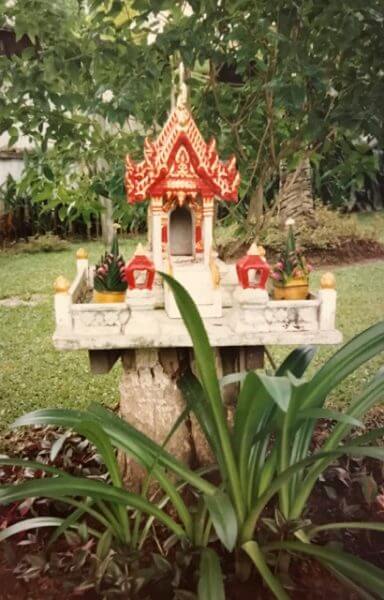 We replaced our spirit house this week. “Spirit house” is the term foreigners use, but strictly speaking, this is not correct. It’s a small replica of a temple on a pedestal. The previous tenant had put one on a stump, which is wrong on two counts: spirit houses are supposed to be at head-level, and stumps rot. Ours did, and the spirit house fell and broke. One is supposed to pray at this replica of a temple, give offerings of flowers, candles and incense, keep it out of the shadow of the house, and generally treat it with respect. It felt like a very bad omen when it broke. Off we went to buy a new one, but that’s not as easy as it sounds. Most of the new ones are garish and poorly made. We trekked, with our gardener as interpreter, to several manufacturers (they also make the paper coffins in which the dead are cremated, as well as the cement urns where their ashes repose). Finally, we purchased an unpainted one and indicated, by putting dabs of paint, what colors we wanted where.
We replaced our spirit house this week. “Spirit house” is the term foreigners use, but strictly speaking, this is not correct. It’s a small replica of a temple on a pedestal. The previous tenant had put one on a stump, which is wrong on two counts: spirit houses are supposed to be at head-level, and stumps rot. Ours did, and the spirit house fell and broke. One is supposed to pray at this replica of a temple, give offerings of flowers, candles and incense, keep it out of the shadow of the house, and generally treat it with respect. It felt like a very bad omen when it broke. Off we went to buy a new one, but that’s not as easy as it sounds. Most of the new ones are garish and poorly made. We trekked, with our gardener as interpreter, to several manufacturers (they also make the paper coffins in which the dead are cremated, as well as the cement urns where their ashes repose). Finally, we purchased an unpainted one and indicated, by putting dabs of paint, what colors we wanted where.
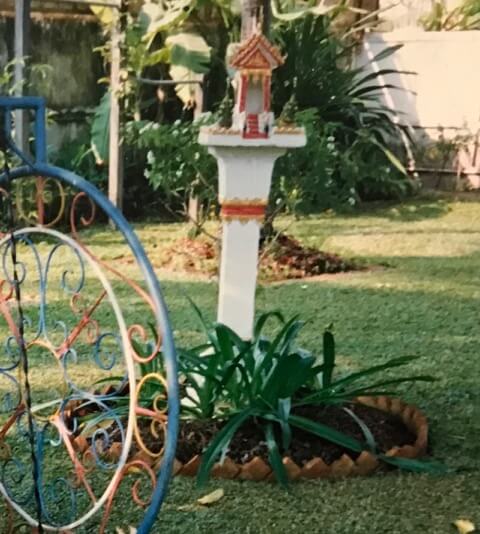 It had to be delivered the next day, so it could be installed in time for our party to say goodbye to friends who are returning to Ireland. They delivered it, but it was wet, and the paint smeared. Then there was a big rain over the weekend, and most of the wet paint washed off. So they returned on Monday, as previously arranged, to pour cement down the pedestal to stabilize it and to repaint the spirit house too. The only problem is that they brought neon green, not dark green, so we’ve ended up with a garish spirit house after all. I feel like this will attract the wrong class of spirits, so I’m trying to find dark green paint and re-do the roof myself.
It had to be delivered the next day, so it could be installed in time for our party to say goodbye to friends who are returning to Ireland. They delivered it, but it was wet, and the paint smeared. Then there was a big rain over the weekend, and most of the wet paint washed off. So they returned on Monday, as previously arranged, to pour cement down the pedestal to stabilize it and to repaint the spirit house too. The only problem is that they brought neon green, not dark green, so we’ve ended up with a garish spirit house after all. I feel like this will attract the wrong class of spirits, so I’m trying to find dark green paint and re-do the roof myself.
September 16
The latest garden project is to put brick borders around the beds and to lay a brick walk and “floor” around the area where we fill the watering cans. Both places get muddy very easily. Now they look pretty spiffy in their new brick. It’s a bit bright right now, but it will weather in a matter of weeks and have moss and other small things growing all over the brick. By the way, brick is incredibly cheap here: 250 for 5000 kip ($7).
September 24
I don’t know if I’ve mentioned that we have an “outside cat.” When we arrived, a sad-looking one-eyed cat was hanging around. We took pity on him and named him Jack (as in one-eyed Jack) and started feeding him. A few weeks ago, he started looking pregnant, so we decided maybe we had a Jackie. Last week, Jack disappeared for a few days, and we wondered if maybe she’d gone off to give birth. Then Jack limped back with a huge hole behind his/her shoulder blades, right through the skin and into the muscle. The driver and gardener said it looked like he’d been shot by the local kids who also shoot birds. Jack’s still too wild to catch, so all we can do is feed him a high protein diet and hope for the best. This morning, it looks like the hole is closing over, so we’re hopeful. We still don’t know if Jack is a he or a she, but Jack is sure fighting for his/her life, and we admire his (I’ll settle for that gender for now) pluck.
October 21
Jack’s wound has healed over, and he’s doing much better!
December 3
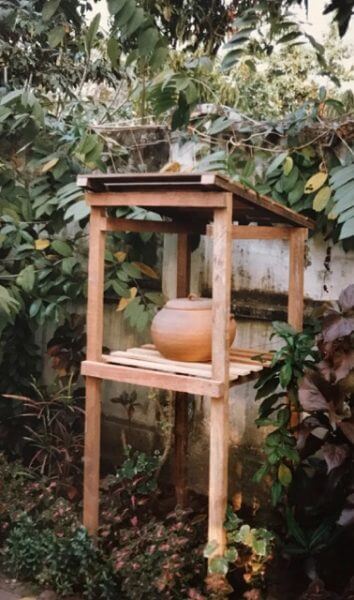 Jack was killed while we were conducting investment promotion conferences in Australia and New Zealand. He was recovering from a second shot to the shoulder when we left in early November. Kham Sing said he’d found Jack lying under our traditional Lao symbol of welcome, a shelter with a ceramic container of drinking water. Despite five pellet holes, he’d managed to drag himself “home” to die. Kham Sing had buried Jack in the back garden, and we planted a palm tree over this grave when we got home. Jack was a tough old guy, but he couldn’t survive five shots.
Jack was killed while we were conducting investment promotion conferences in Australia and New Zealand. He was recovering from a second shot to the shoulder when we left in early November. Kham Sing said he’d found Jack lying under our traditional Lao symbol of welcome, a shelter with a ceramic container of drinking water. Despite five pellet holes, he’d managed to drag himself “home” to die. Kham Sing had buried Jack in the back garden, and we planted a palm tree over this grave when we got home. Jack was a tough old guy, but he couldn’t survive five shots.
By odd coincidence, a small orange tabby kitten with blue eyes showed up in the back garden only a couple of days after we planted the tree. Maybe it’s Jack’s spirit returned to try again. More likely, it fell off the wall while strolling with its mother who appears now and again with another kitten, same coloring but with white markings. At any rate, we’re putting out milk in a saucer, and we’re likely to have another outside cat — Jack’s Christmas present?
December 8
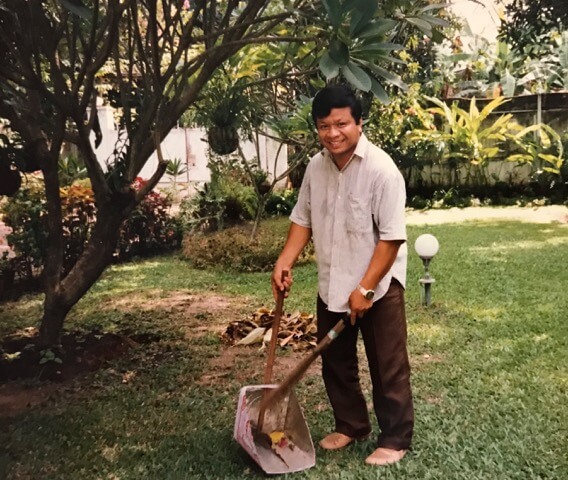 Kham Sing has returned from Champassak, in the South. He’s been gone for a couple of weeks because his father died. Kham Sing is a very special person, and we all missed him. We worked together for a couple of hours today, and it was a real pleasure.
Kham Sing has returned from Champassak, in the South. He’s been gone for a couple of weeks because his father died. Kham Sing is a very special person, and we all missed him. We worked together for a couple of hours today, and it was a real pleasure.
The kitten continues to thrive. His mum pops over the wall to suckle him now and then. Our saucers of milk disappear. Can’t decide whether she’s drinking it or he is. Either way, he gets it, I guess. I looked out the window today, and he was bopping along the foot-high ledge at the base of the wall. I think he’s feeling more secure here, and we’re trying to let him find his own way to being at home.
December 15
The kitten is getting used to me. I put out a saucer of milk every morning. First he watched his mother drink it. Then he started lapping at her side. Now he doesn’t even wait for her and just dives in. If I come into his section of the yard unexpectedly, he doesn’t run away. He just watches, and as long as I don’t get too close, he can handle this big cat with no tail.
1993
January 13
Sadly, both kittens were killed while we were [on vacation in Vietnam]. This is a hard place for cats. Both people and other felines go after them. Fortunately, we still have Madame Maeo, but we keep a close watch on her and don’t allow her out after dusk. She, of course, doesn’t like this arrangement at all and gives us a daily talking-to when we won’t open the door for her.
March 31
Our avocado trees are about to bear their first crop, and we are very much looking forward to them. Mango season is about to begin, and we’ve already got mangosteens, the favorite tropical fruit of Queen Victoria and mine too.
June 9
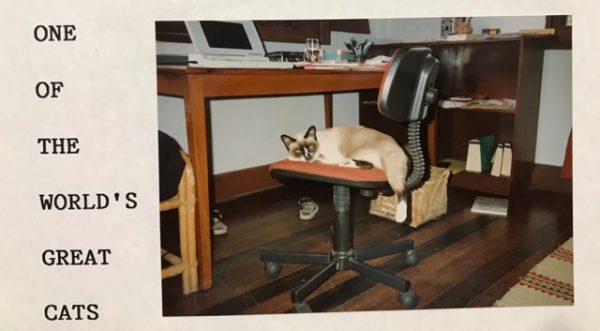 Busy with all the necessary activities as our departure nears. We put up a sign with the message, “One of the World’s Great Cats is Looking for a New Home,” and featuring a photo of Madame Maeo asleep by the computer. We’ve already had one inquiry — a man who jokingly offered to send references and wondered if Maeo could do spreadsheets.
Busy with all the necessary activities as our departure nears. We put up a sign with the message, “One of the World’s Great Cats is Looking for a New Home,” and featuring a photo of Madame Maeo asleep by the computer. We’ve already had one inquiry — a man who jokingly offered to send references and wondered if Maeo could do spreadsheets.
* * *
Living and working in developing countries means saying a lot of goodbyes. All these animals graced our lives. Losing or leaving each one was like losing a family member. And we never again had a tropical garden.

COMING NEXT MONTH
The challenges of climate, health, overseas guests,
freaky hot water heaters and cooking on a VERY small stove.

LET ME HEAR FROM YOU.
Please take a moment to share your thoughts.
Your comments help make the blog better, and I always answer.
* * *
If you enjoyed reading this post, I hope you’ll SUBSCRIBE by clicking on the button below. Every month, when I post a new excerpt from my life overseas, you’ll get an email with a link so you can read the next installment. Subscription is free, and I won’t share your contact information with anyone else. Your subscribing lets me know you’re reading what I write, and that means a lot.

